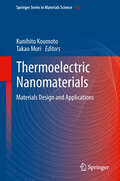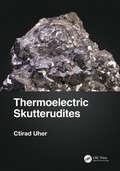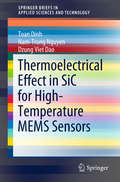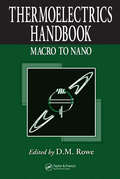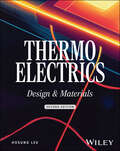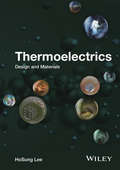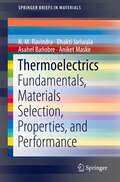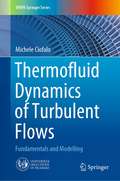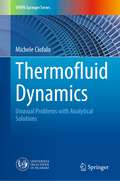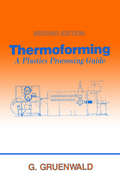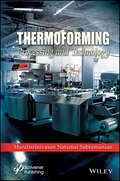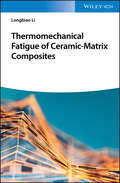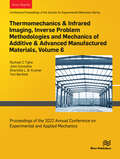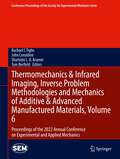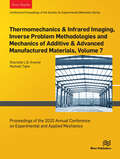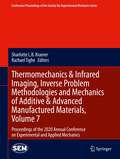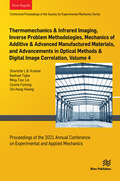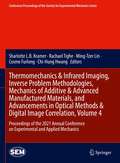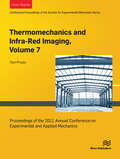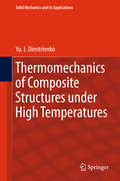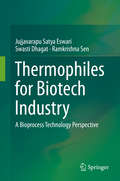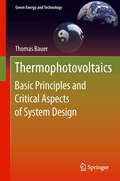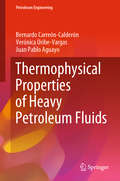- Table View
- List View
Thermoelectric Nanomaterials: Materials Design and Applications
by Kunihito Koumoto Takao MoriPresently, there is an intense race throughout the world to develop good enough thermoelectric materials which can be used in wide scale applications. This book focuses comprehensively on very recent up-to-date breakthroughs in thermoelectrics utilizing nanomaterials and methods based in nanoscience. Importantly, it provides the readers with methodology and concepts utilizing atomic scale and nanoscale materials design (such as superlattice structuring, atomic network structuring and properties control, electron correlation design, low dimensionality, nanostructuring, etc.). Furthermore, also indicates the applications of thermoelectrics expected for the large emerging energy market. This book has a wide appeal and application value for anyone being interested in state-of-the-art thermoelectrics and/or actual viable applications in nanotechnology.
Thermoelectric Skutterudites
by Ctirad UherThis book informs the reader about a fascinating class of materials referred to as skutterudites, the atomic lattice of which has large structural voids that can be filled by a variety of foreign species, spanning from alkali to alkaline to rare earth ions. The fillers, in their unique way, drastically modify the physical properties of the parent structure, giving rise to outstanding thermoelectric properties. This exciting material is of growing importance and is finding applications in a variety of different fields. This book will be of interest to researchers working in materials science, physics, and chemistry in addition to graduate students in these subjects. Features:• Gives a comprehensive account of all fundamental physical properties of skutterudites• Each major topic is accompanied by introductory sections and a further detailed theoretical treatment is provided in Appendices• Supported by many figures and a vast number of relevant references
Thermoelectric Thin Films: Materials and Devices
by Kanishka Biswas Paolo Mele Tamio Endo Dario Narducci Michihiro Ohta Juan Morante Shrikant SainiThis book will provide readers with deep insight into the intriguing science of thermoelectric thin films. It serves as a fundamental information source on the techniques and methodologies involved in thermoelectric thin film growth, characterization and device processing. This book involves widespread contributions on several categories of thermoelectric thin films: oxides, chalcogenides, iodates, nitrides and polymers. This will serve as an invaluable resource for experts to consolidate their knowledge and will provide insight and inspiration to beginners wishing to learn about thermoelectric thin films.Provides a single-source reference on a wide spectrum of topics related to thermoelectric thin films, from organic chemistry to devices, from physical chemistry to applied physics, from synthesis to device implementation;Covers several categories of thermoelectric thin films based on different material approaches such as oxides, chalcogenides, iodates, nitrides and polymers;Discusses synthesis, characterization, and device processing of thermoelectric thin films, as well as the nanoengineering approach to tailor the properties of the used materials at the nanoscale level.
Thermoelectrical Effect in SiC for High-Temperature MEMS Sensors (SpringerBriefs in Applied Sciences and Technology)
by Toan Dinh Nam-Trung Nguyen Dzung Viet DaoThis book presents the fundamentals of the thermoelectrical effect in silicon carbide (SiC), including the thermoresistive, thermoelectric, thermocapacitive and thermoelectronic effects. It summarizes the growth of SiC, its properties and fabrication processes for SiC devices and introduces the thermoelectrical sensing theories in different SiC morphologies and polytypes. Further, it reviews the recent advances in the characterization of the thermoelectrical effect in SiC at high temperatures. Discussing several desirable features of thermoelectrical SiC sensors and recent developments in these sensors, the book provides useful guidance on developing high sensitivity and linearity, fast-response SiC sensing devices based on thermoelectrical effects.
Thermoelectrics Handbook: Macro to Nano
by D. M. RoweTen years ago, D.M. Rowe introduced the bestselling CRC Handbook of Thermoelectrics to wide acclaim. Since then, increasing environmental concerns, desire for long-life electrical power sources, and continued progress in miniaturization of electronics has led to a substantial increase in research activity involving thermoelectrics. Reflecting the latest trends and developments, the Thermoelectrics Handbook: Macro to Nano is an extension of the earlier work and covers the entire range of thermoelectrics disciplines.Serving as a convenient reference as well as a thorough introduction to thermoelectrics, this book includes contributions from 99 leading authorities from around the world. Its coverage spans from general principles and theoretical concepts to material preparation and measurements; thermoelectric materials; thermoelements, modules, and devices; and thermoelectric systems and applications. Reflecting the enormous impact of nanotechnology on the field-as the thermoelectric properties of nanostructured materials far surpass the performance of conventional materials-each section progresses systematically from macro-scale to micro/nano-scale topics. In addition, the book contains an appendix listing major manufacturers and suppliers of thermoelectric modules.There is no longer any need to spend hours plodding through the journal literature for information. The Thermoelectrics Handbook: Macro to Nano offers a timely, comprehensive treatment of all areas of thermoelectrics in a single, unified reference.
Thermoelectrics: Design and Materials
by HoSung LeeComplete introduction to the field of thermoelectrics, covering materials, applications, recent developments, and more, with end-of-chapter problems included throughout Thermoelectrics provides an introduction to the fundamental theories in the fast developing and interdisciplinary field of thermoelectrics. The topics covered are in sync with contemporary technology advancement happenings within the TEC/TEG electronics cooling community and include discussion of challenges and concerns surrounding practical applications. The first section covers thermoelectric generators and coolers (refrigerators) before examining optimal design with dimensional analysis. A number of applications are considered, including solar thermoelectric generators, thermoelectric air conditioners and refrigerators, thermoelectric coolers for electronic devices, thermoelectric compact heat exchangers, and biomedical thermoelectric energy harvesting systems. The second section focuses on materials and covers the physics of electrons and phonons, theoretical modeling of thermoelectric transport properties, thermoelectric materials, and nanostructures. In this Second Edition, many new examples and end-of-chapter problems have been added. New results from the theories have been added in certain chapters, along with new design charts and many examples showing how to use the charts. A companion website hosts solution manuals and appendices. Sample topics covered in Thermoelectrics include: Thermoelectric effects, including the Seebeck, Peltier, and Thomson effects as well as Thomson/Kelvin relationshipsPerformance, maximum, abnormal parameters for thermoelectric modules as well as effective material propertiesThermal and electrical contact resistances for micro and macro devices, with information on modeling and validationThermoelectric transport properties, covering Seebeck coefficient, electrical conductivity, lattice and electronic thermal conductivitiesLow-dimensional nanostructures, covering quantum wells, wires, and dots and supporting proof-of-principle studies Thermoelectrics is an ideal resource on the fundamentals of the subject for professionals in the electronics cooling industry, solid state physicists, and materials scientists and engineers. It is also a valuable reference for early career scientists and undergraduate and graduate students in related programs of study.
Thermoelectrics: Design and Materials
by Hosung LeeThermoelectrics: Design and Materials HoSung Lee, Western Michigan University, USA A comprehensive guide to the basic principles of thermoelectrics Thermoelectrics plays an important role in energy conversion and electronic temperature control. The book comprehensively covers the basic physical principles of thermoelectrics as well as recent developments and design strategies of materials and devices. The book is divided into two sections: the first section is concerned with design and begins with an introduction to the fast developing and multidisciplinary field of thermoelectrics. This section also covers thermoelectric generators and coolers (refrigerators) before examining optimal design with dimensional analysis. A number of applications are considered, including solar thermoelectric generators, thermoelectric air conditioners and refrigerators, thermoelectric coolers for electronic devices, thermoelectric compact heat exchangers, and biomedical thermoelectric energy harvesting systems. The second section focuses on materials, and covers the physics of electrons and phonons, theoretical modeling of thermoelectric transport properties, thermoelectric materials, and nanostructures. Key features: Provides an introduction to a fast developing and interdisciplinary field. Includes detailed, fundamental theories. Offers a platform for advanced study. Thermoelectrics: Design and Materials is a comprehensive reference ideal for engineering students, as well as researchers and practitioners working in thermodynamics. Cover designed by Yujin Lee
Thermoelectrics: Fundamentals, Materials Selection, Properties, and Performance (SpringerBriefs in Materials)
by N. M. Ravindra Bhakti Jariwala Asahel Bañobre Aniket MaskeThis book provides a concise but comprehensive introduction to the fundamentals and current state of the art in thermoelectrics. Addressing an audience of materials scientists and engineers, the book covers theory, materials selection, and applications, with a wide variety of case studies reflecting the most up-to-date research approaches from the past decade, from single crystal to polycrystalline form and from bulk to thin films to nano dimensions. The world is facing major challenges for finding alternate energy sources that can satisfy the increasing demand for energy consumption while preserving the environment. The field of thermoelectrics has long been recognized as a potential and ideal source of clean energy. However, the relatively low conversion efficiency of thermoelectric devices has prevented their utility on a large scale. While addressing the need for thermal management in materials, device components, and systems, thermoelectrics provides a fundamental solution to waste heat recovery and temperature control. This book summarizes the global efforts that have been made to enhance the figure of merit of various thermoelectric materials by choosing appropriate processes and their influence on properties and performance. Because of these advances, today, thermoelectric devices are found in mainstream applications such as automobiles and power generators, as opposed to just a few years ago when they could only be used in niche applications such as in aeronautics, infrared imaging, and space. However, the continued gap between fundamental theoretical results and actual experimental data of figure of merit and performance continues to challenge the commercial applications of thermoelectrics. This book presents both recent achievements and continuing challenges, and represents essential reading for researchers working in this area in universities, industry, and national labs.
Thermofluid Dynamics of Turbulent Flows: Fundamentals and Modelling (UNIPA Springer Series)
by Michele CiofaloThe book provides the theoretical fundamentals on turbulence and a complete overview of turbulence models, from the simplest to the most advanced ones including Direct and Large Eddy Simulation. It mainly focuses on problems of modeling and computation, and provides information regarding the theory of dynamical systems and their bifurcations. It also examines turbulence aspects which are not treated in most existing books on this subject, such as turbulence in free and mixed convection, transient turbulence and transition to turbulence. The book adopts the tensor notation, which is the most appropriate to deal with intrinsically tensor quantities such as stresses and strain rates, and for those who are not familiar with it an Appendix on tensor algebra and tensor notation are provided.
Thermofluid Dynamics: Unusual Problems with Analytical Solutions (UNIPA Springer Series)
by Michele CiofaloThis book gathers ten thermofluid dynamics problems involving the use of analytical solutions. All these problems have been encountered by the author during his research activity; some of the solutions are his own contributions, while others either are classic literature results or can be derived from them. The physical phenomena involved range from pure hydrodynamics to flow with heat or mass transfer, two-phase flow, and magnetohydrodynamics. The problems discussed are not canonical problems; they are rarely found in textbooks, and often exhibit surprising, or even paradoxical, solutions. The potential readership of the book includes students, teachers and scientists in science and engineering interested in fluid dynamics and heat/mass transfer: to them it may offer food for thought, suggestions for lectures or tutorials and ideas for further original developments.
Thermoforming: A Plastics Processing Guide, Second Edition
by Geza GruenwaldFROM THE FOREWORDDr. Gruenwald has indicated the desirable properties of polymerics for differing applications; thus, his text is especially useful for polymer chemists who must ""tailor"" plastic materials for specific groups of applications. Engineers in extruding and calendering film and sheet will benefit from the intimate relationships elucidated between processing parameters imposed upon stocks employed in thermoforming and the products thereof. Mold designers are provided with a complete guide that will enable them to avoid the less obvious pitfalls and wasted effort so often experienced in the evolution of molds for (especially) complex parts.. Quite likely, Dr. Gruenwald's suggestions willl lead to considerable benefits to those who read and practice by this remarkable exposition of thermoforming technology. Robert K. Jordan Director-Metalliding Institute, Director-Engineering Research Institute, Scientist in Residence, Gannon University
Thermoforming: Processing and Technology
by Muralisrinivasan Natamai SubramanianThis book is a comprehensive reference manual that contains essential information on thermoforming processing and technology. The field of thermoforming is experiencing rapid development driven by commercial factors; millions of tons of polymers are manufactured for use in various applications, both as commodity and specialty polymers. Building on the previous edition published about ten years ago, this edition includes new, as well as, fully revised chapters and updated information on materials and processes. The book is designed to provide practitioners with essential information on processing and technology in a concise manner. The book caters to both engineers and experts by providing introductory aspects, background information, and an overview of thermoforming processing and technology. The troubleshooting section includes flowcharts to assist in correcting thermoforming processes. >em>Thermoforming: Processing and Technology offers a complete account of thermoplastics, covering properties and forming, with chapters providing perspective on the technologies involved. Readers will find it: serves as a handy knowledge source for professionals who occasionally work on thermoforming projects or need to refresh their knowledge; offers a troubleshooting guide that can help to identify and solve challenges that may arise in thermoforming processes; provides insights into process optimization, helping businesses improve efficiency, reduce waste, and enhance the quality of thermoformed products; acts as a course book to inform students about the thermoforming process. Audience The book will be of interest to mechanical, materials engineers, and process engineers who are involved in designing and optimizing thermoforming processes; professionals in the manufacturing and production industries who use thermoforming as a manufacturing method, such as in the production of plastic packaging, automotive components, and consumer goods; scientists, researchers, and students in plastics/polymer engineering and technology, materials science, polymer technology; professionals responsible for ensuring product quality and compliance with industry standards.
Thermomechanical Fatigue of Ceramic-Matrix Composites
by Longbiao LiGuides researchers and practitioners toward developing highly reliable ceramic-matrix composites The book systematically introduces the thermomechanical fatigue behavior of fiber-reinforced ceramic-matrix composites (CMCs) and environmental barrier coatings, including cyclic loading/unloading tensile behavior, cyclic fatigue behavior, dwell-fatigue behavior, thermomechanical fatigue behavior, and interface degradation behavior. It discusses experimental verification of CMCs and explains how to determine the thermomechanical properties. It also presents damage evolution models, lifetime prediction methods, and interface degradation rules. Thermomechanical Fatigue of Ceramic-Matrix Composites offers chapters covering unidirectional ceramic-matrix composites and cross-ply and 2D woven ceramic-matrix composites. For cyclic fatigue behavior of CMCs, it looks at the effects of fiber volume fraction, fatigue peak stress, fatigue stress ratio, matrix crack spacing, matrix crack mode, and woven structure on fatigue damage evolution. Both the Dwell-fatigue damage evolution and lifetime predictions models are introduced in the next chapter. Experimental comparisons of the cross-ply SiC/MAS composite, 2D SiC/SiC composite, and 2D NextelTM 720/Alumina composite are also included. Remaining sections examine: thermomechanical fatigue hysteresis loops; in-phase thermomechanical fatigue damage; out-of-phase thermomechanical fatigue; interface degradation models; and much more. -Offers unique content dedicated to thermomechanical fatigue behavior of ceramic-matrix composites (CMCs) and environmental barrier coatings -Features comprehensive data tables and experimental verifications -Covers a highly application-oriented subject?CMCs are being increasingly utilized in jet engines, industrial turbines, and exhaust systems Thermomechanical Fatigue of Ceramic-Matrix Composites is an excellent book for developers and users of CMCs, as well as organizations involved in evaluation and characterization of CMCs. It will appeal to materials scientists, construction engineers, process engineers, and mechanical engineers.
Thermomechanics & Infrared Imaging, Inverse Problem Methodologies and Mechanics of Additive & Advanced Manufactured Materials, Volume 6: Proceedings of the 2022 Annual Conference on Experimental and Applied Mechanics
by John Considine Rachael C Tighe Tom Berfield Kramer, Sharlotte L. B.Thermomechanics & Infrared Imaging, Inverse Problem Methodologies and Mechanics of Additive & Advanced Manufactured Materials, Volume 6 of the Proceedings of the 2022 SEM Annual Conference & Exposition on Experimental and Applied Mechanics, the sixth volume of six from the Conference, brings together contributions to this important area of research and engineering. The collection presents early findings and case studies on a wide range of areas, including: Test Design and Inverse Method Algorithms Inverse Problems: Virtual Fields Method Material Characterizations Using Thermography Fatigue, Damage & Fracture Evaluation Using Infrared Thermography Residual Stress Mechanics of Additive & Advanced Manufactured Materials.
Thermomechanics & Infrared Imaging, Inverse Problem Methodologies and Mechanics of Additive & Advanced Manufactured Materials, Volume 6: Proceedings of the 2022 Annual Conference on Experimental and Applied Mechanics (Conference Proceedings of the Society for Experimental Mechanics Series)
by John Considine Sharlotte L. B. Kramer Rachael C Tighe Tom BerfieldThermomechanics & Infrared Imaging, Inverse Problem Methodologies and Mechanics of Additive & Advanced Manufactured Materials, Volume 6 of the Proceedings of the 2022 SEM Annual Conference & Exposition on Experimental and Applied Mechanics, the sixth volume of six from the Conference, brings together contributions to this important area of research and engineering. The collection presents early findings and case studies on a wide range of areas, including: Test Design and Inverse Method Algorithms Inverse Problems: Virtual Fields Method Material Characterizations Using Thermography Fatigue, Damage & Fracture Evaluation Using Infrared Thermography Residual Stress Mechanics of Additive & Advanced Manufactured Materials
Thermomechanics & Infrared Imaging, Inverse Problem Methodologies and Mechanics of Additive & Advanced Manufactured Materials, Volume 7: Proceedings of the 2020 Annual Conference on Experimental and Applied Mechanics
by Rachael Tighe Kramer, Sharlotte L.B.Residual Stress, Thermomechanics & Infrared Imaging and Inverse Problems, Volume 7 of the Proceedings of the 2020 SEM Annual Conference & Exposition on Experimental and Applied Mechanics, the seventh volume of seven from the Conference, brings together contributions to this important area of research and engineering. The collection presents early findings and case studies on a wide range of areas, including: Test Design and Inverse Method Algorithms Inverse Problems: Virtual Fields Method Residual Stresses: Measurement, Uncertainty & Validation Residual Stresses: Eigenvalues, Modeling, & Crack Growth Material Characterizations Using Thermography Fatigue, Damage & Fracture Evaluation Using Infrared Thermography.
Thermomechanics & Infrared Imaging, Inverse Problem Methodologies and Mechanics of Additive & Advanced Manufactured Materials, Volume 7: Proceedings of the 2020 Annual Conference on Experimental and Applied Mechanics (Conference Proceedings of the Society for Experimental Mechanics Series)
by Sharlotte L. B. Kramer Rachel TigheResidual Stress, Thermomechanics & Infrared Imaging and Inverse Problems, Volume 7 of the Proceedings of the 2020 SEM Annual Conference & Exposition on Experimental and Applied Mechanics, the seventh volume of sseven from the Conference, brings together contributions to this important area of research and engineering. The collection presents early findings and case studies on a wide range of areas, including:Test Design and Inverse Method AlgorithmsInverse Problems: Virtual Fields MethodResidual Stresses: Measurement, Uncertainty & ValidationResidual Stresses: Eigenvalues, Modeling, & Crack GrowthMaterial Characterizations Using ThermographyFatigue, Damage & Fracture Evaluation Using Infrared Thermography
Thermomechanics & Infrared Imaging, Inverse Problem Methodologies, Mechanics of Additive & Advanced Manufactured Materials, and Advancements in Optical Methods & Digital Image Correlation, Volume 4: Proceedings of the 2021 Annual Conference and Exposition on Experimental and Applied Mechanics
by Cosme Furlong Ming-Tzer Lin Chi-Hung Hwang Rachael Tighe Kramer, Sharlotte L. B.Thermomechanics & Infrared Imaging, Inverse Problem Methodologies and Mechanics of Additive & Advanced Manufactured Materials, and Advancement of Optical Methods & Digital Image Correlation, Volume 4 of the Proceedings of the 2021 SEM Annual Conference & Exposition on Experimental and Applied Mechanics, the fourth volume of four from the Conference, brings together contributions to this important area of research and engineering. The collection presents early findings and case studies on a wide range of areas, including: Test Design and Inverse Method Algorithms, Inverse Problems: Virtual Fields Method, Material Characterizations, Using Thermography Fatigue, Damage & Fracture Evaluation Using Infrared, Thermography Mechanics of Additive & Advanced Manufactured Materials, DIC Methods & Its Application,s Photoelasticity and Interferometry Applications, Micro-Optics and Microscopic Systems, Multiscale and New Developments in Optical Methods.
Thermomechanics & Infrared Imaging, Inverse Problem Methodologies, Mechanics of Additive & Advanced Manufactured Materials, and Advancements in Optical Methods & Digital Image Correlation, Volume 4: Proceedings of the 2021 Annual Conference on Experimental and Applied Mechanics (Conference Proceedings of the Society for Experimental Mechanics Series)
by Cosme Furlong Ming-Tzer Lin Chi-Hung Hwang Sharlotte L. B. Kramer Rachael TigheThermomechanics & Infrared Imaging, Inverse Problem Methodologies and Mechanics of Additive & Advanced Manufactured Materials, and Advancement of Optical Methods & Digital Image Correlation, Volume 4 of the Proceedings of the 2021 SEM Annual Conference & Exposition on Experimental and Applied Mechanics, the fourth volume of four from the Conference, brings together contributions to this important area of research and engineering. The collection presents early findings and case studies on a wide range of areas, including: Test Design and Inverse Method Algorithms Inverse Problems: Virtual Fields Method Material Characterizations Using Thermography Fatigue, Damage & Fracture Evaluation Using Infrared Thermography Mechanics of Additive & Advanced Manufactured Materials DIC Methods & Its Applications Photoelasticity and Interferometry Applications Micro-Optics and Microscopic Systems Multiscale and New Developments in Optical Methods
Thermomechanics and Infra-Red Imaging, Volume 7: Proceedings of the 2011 Annual Conference on Experimental and Applied Mechanics
by Tom ProulxThermomechanics and Infra-Red Imaging represents one of eight volumes of technical papers presented at the Society for Experimental Mechanics Annual Conference on Experimental and Applied Mechanics, held at Uncasville, Connecticut, June 13-16, 2011. The full set of proceedings also includes volumes on Dynamic Behavior of Materials, Mechanics of Biological Systems and Materials, Mechanics of Time-Dependent Materials and Processes in Conventional and Multifunctional Materials, MEMS and Nanotechnology; Optical Measurements, Modeling and, Metrology; Experimental and Applied Mechanics, and Engineering Applications of Residual Stress.
Thermomechanics of Composite Structures under High Temperatures
by Yu. I. DimitrienkoThispioneering book presents new models for the thermomechanical behavior ofcomposite materials and structures taking into account internalphysico-chemical transformations such as thermodecomposition, sublimation andmelting at high temperatures (up to 3000 K). It is of great importance forthe design of new thermostable materials and for the investigation ofreliability and fire safety of composite structures. It also supports theinvestigation of interaction of composites with laser irradiation and thedesign of heat-shield systems. Structural methods are presented for calculating the effective mechanical andthermal properties of matrices, fibres and unidirectional, reinforced bydispersed particles and textile composites, in terms of properties of their constituentphases. Useful calculation methods are developed for characteristics such asthe rate of thermomechanical erosion of composites under high-speed flow andthe heat deformation of composites with account of chemical shrinkage. The author expansively compares modeling results with experimental data, andreaders will find unique experimental results on mechanical and thermalproperties of composites under temperatures up to 3000 K. Chapters show how thebehavior of composite shells under high temperatures is simulated by thefinite-element method and so cylindrical and axisymmetric composite shells andcomposite plates are investigated under local high-temperature heating.
Thermophiles for Biotech Industry: A Bioprocess Technology Perspective
by Swasti Dhagat Jujjavarapu Satya Eswari Ramkrishna SenThermophiles and hyperthermophiles exhibit great biotechnological potential, as they can be utilized in processes which require higher temperatures. This book comprehensively deals with all the aspects of thermophiles, starting from the source of these organisms to their latest applications. In addition it presents a compilation of all compounds produced by various thermophilic microorganisms. Due to their application in everyday life, the demands of enzymes that can work at higher temperature have been increasing. In order to keep pace with the increasing demand the industries have to search novel thermophiles producing their product of interest. Hence, this book will be of value for industries working on various biochemical products produced by these thermophiles as well as for scientists and research scholars working on microbiology and products derived from microorganisms.
Thermophotovoltaics
by Thomas BauerThermophotovoltaics is the science and technology associated with the direct generation of electricity from high temperature heat. Potential applications include combined heat and power, portable and auxiliary power, radioisotope space power, industrial waste heat recovery and concentrated solar power. This book aims at serving as an introduction to the underlying theory, overview of present day components and system arrangements, and update of the latest developments in the field. The emphasis is placed on the understanding of the critical aspects of efficient thermophotovoltaic system design. The aim is to assist researchers in the field.
Thermophysical Properties and Measuring Technique of Ge-Sb-Te Alloys for Phase Change Memory
by Rui LanThis book focuses on the thermophysical properties of Ge-Sb-Te alloys, which are the most widely used phase change materials, and the technique for measuring them. Describing the measuring procedure and parameter calibration in detail, it provides readers with an accurate method for determining the thermophysical properties of phase change materials and other related materials. Further, it discusses combining thermal and electrical conductivity data to analyze the conduction mechanism, allowing readers to gain an understanding of phase change materials and PCM industry simulation.
Thermophysical Properties of Heavy Petroleum Fluids (Petroleum Engineering)
by Bernardo Carreón-Calderón Verónica Uribe-Vargas Juan Pablo AguayoThis book addresses conventional and new predictive methodologies for estimating thermophysical properties of heavy petroleum fluids. For the unidentifiable fractions forming the fluids, chemical structures are calculated so that property estimation methods for mixtures of identifiable components are now available for such fractions. Chemical and multiphase equilibriums are of utmost importance; hence, the most significant ones involving heavy petroleum fluids are determined and illustrated using advanced equations of state such as sPC-SAFT and EoS/GE. The included phase equilibriums are phase envelopes of reservoir fluids, asymmetric mixtures between light solvents and bitumen including the presence of water and asphaltenes, among others. Besides, heavy petroleum fluids are analyzed from the Newtonian and non-Newtonian viewpoints, exploring their complex rheological behavior. Finally, complemented by online an Excel program for the thermodynamic characterization of unidentifiable petroleum fractions, this book is a useful resource for engineers and researchers in the petroleum industry and is also of interest to students studying chemical and petroleum engineering.
